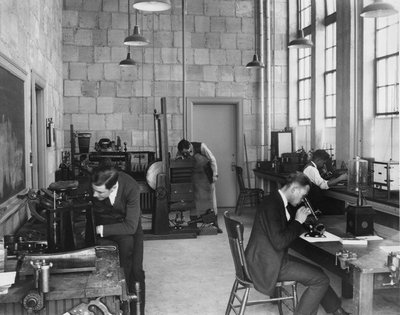November 8, 2007
100 years and counting: Forest Resources celebrates centennial with research showcase, gala
Tuition early on was $10 a semester and courses ranged from wood technology — including learning how to recognize the commercial timbers of the United States and know their properties — to forest protection, which mainly concerned how to thwart fungi, insect pests and forest fires on timberlands.
The class on “woodcraft” was a first semester course required of all freshmen to learn about, “Food lists, camp cooking, woods clothing, camp equipment, camp sanitation, packing a horse, general woodcraft. Course concludes with a half dozen lectures on first aid to the injured.”
When the UW College of Forest Resources was founded in 1907, called at that time the School of Forestry, the Pacific Northwest was the center of the timber industry and, by 1910, Washington led the nation in lumber production.
“. . .Seattle is in the center of the timber industry of Washington and the Northwest,” a 1917 college catalog explains to potential students. “In its many sawmills and wood-working industries, the student has unrivaled opportunities for studying wood utilization.” The catalog describes the 335-acre UW campus as partly covered with timber and that work was under way on an arboretum, forerunner to the Washington Park Arboretum that is managed today by the college in partnership with the City of Seattle.
The college took the opportunity to look back in time, and look forward to the next 100 years, last weekend during anniversary activities including a research showcase on bioenergy and a gala in the Don James Center attended by 250 alums, students, faculty, staff and supporters.
For much of its history, the college grouped professional interests into forest management, logging engineering and forest products. In the last 35 to 40 years, those areas have been broadened in response to increasing attention to environmental and natural resources sustainability, climate change and biodiversity issues, and changes in how green spaces are valued by urban and rural residents. The college also has increased its international focus, participating in UW worldwide initiatives and studying the sustainability of habitats and issues of global trade in places such as Costa Rica, Bolivia, China and Japan.
Natural resources management is now much more about integrated uses, says Bruce Bare, current dean of the college, who’s striven in recent years to have the college focus on issues of natural resources sustainability.
This fall, for example, the college conducted another of its Northwest Environmental Forums looking at Washington’s working forests, those forests that include areas managed for both forest commodities, such as timber, and environmental services such as fresh water, sequestration of carbon and wildlife habitat. The forum, a kind of think tank, brought together representatives of forest companies, small landowners, environmental advocates, Native American tribes, legislative staff members and agencies.
As another example, earlier this year the college provided the Legislature with five studies with the latest information about the susceptibility of Eastside forests to wildfires and insect invasions, pressure on some forests to be converted to other uses such as housing developments and the state of the forest products industry and rural communities.
Then the Legislature appropriated money for the college to develop recommendations on prioritizing forest lands at risk for conversion, especially in the Cascade foothills, as well as exploring the potential for using forest biomass to generate energy and considering markets for such biomass.
The college has been responsive to changes in society’s values, global trade and the wood products field, among other things, says David Thorud, dean emeritus who joined the college 26 years ago.
In the recent 18 months the college has faced having one-fifth of its faculty retire. The college has added 11 new faces, nine tenure track faculty and two joint appointments, one with WSU and the other with the U.S. Geological Survey. It’s been an opportunity to add expertise in new disciplines and endeavors.
“Bruce Bare and company are doing well in bringing in new skills and new technology levels in recently hired faculty to work in combination with seasoned faculty,” Thorud says.
For example, faculty members Rick Gustafson, Kevin Hodgson and Bill McKean and staff member Larry Mason, were joined at last weekend’s research showcase by three new assistant professors. Renata Bura is a chemist studying how to unlock the lignin that surrounds wood cells allowing more ready conversion of lignocellulosic biomass to ethanol and other fuels. Monica Moskal, who brings a background in remote sensing, last weekend talked about using LIDAR to estimate the amount of biomass in stands of trees. And Sharon Doty is a biotechnologist using genetic techniques and microorganisms found in poplar trees who talked about optimizing the trees for biofuel production.
Just last month Doty was lead author on a publication that appeared in the Proceedings of the National Academy of Sciences on poplars bioengineered to enhance another one of their abilities, that of taking up harmful groundwater pollutants and breaking them into harmless components. In another junior-senior faculty collaboration, Professor Stuart Strand is principal investigator on the project and a co-author on the paper.
“From my perspective, a significant change forestry has undergone in the past 35 years is moving out of its strictly professional domain and into the broader arena of science,” says Reinhard Stettler, professor emeritus who joined the college 44 years ago. “Whereas traditional research used to be published exclusively in forestry journals, today you’ll find much of it written up in Nature, Science, Proceedings of the National Academy of Sciences and more.
“The College of Forest Resources has played a distinguished role in this transformation largely through the nature and quality of faculty it has hired, its attraction of well qualified graduate students and the collaboration with other disciplines across campus it has encouraged.”



